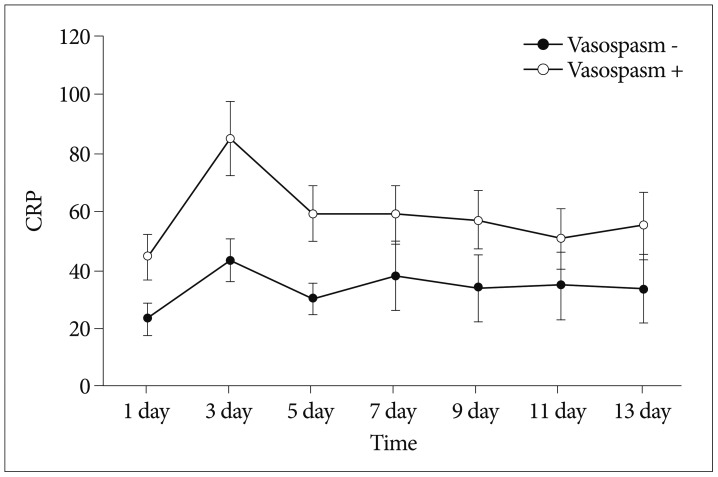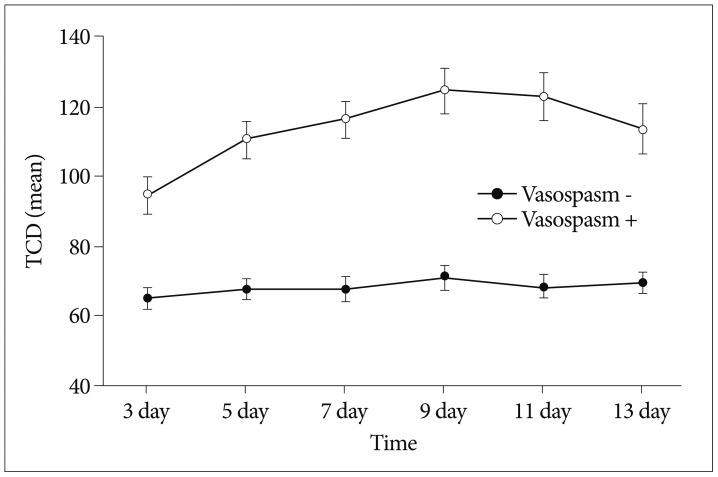J Korean Neurosurg Soc.
2013 Oct;54(4):289-295. 10.3340/jkns.2013.54.4.289.
Significance of C-Reactive Protein and Transcranial Doppler in Cerebral Vasospasm Following Aneurysmal Subarachnoid Hemorrhage
- Affiliations
-
- 1Department of Neurosurgery, Chung-Ang University College of Medicine, Seoul, Korea. cuttage@cau.ac.kr
- 2Medical Device Clinical Trials Center, Chung-Ang University College of Medicine, Seoul, Korea.
- KMID: 1499333
- DOI: http://doi.org/10.3340/jkns.2013.54.4.289
Abstract
OBJECTIVE
Cerebral vasospasm is a common and potentially devastating complication of aneurysmal subarachnoid hemorrhage (aSAH). Inflammatory processes seem to play a major role in the pathogenesis of vasospasm. C-reactive protein (CRP) constitutes a highly sensitive inflammatory marker. Elevation of serum CRP levels has been demonstrated in patients with aSAH. The purpose of the current study was to evaluate the possible relationship between CRP levels in the serum and transcranial Doppler (TCD) and the development of vasospasm in patients with aSAH.
METHODS
A total of 61 adult patients in whom aSAH was diagnosed were included in the study from November 2008 to May 2011. The patients' demographics, Hunt and Hess grade, Fisher grade, CT scans, digital subtraction angiography studies, and daily neurological examinations were recorded. Serial serum CRP measurements were obtained on days 1, 3, 5, 7, 9, 11 and 13 and TCD was measured on days 3, 5, 7, 9, 11 and 13. All patients underwent either surgical or endovascular treatment within 24 hours of their hemorrhagic attacks.
RESULTS
Serum CRP levels peaked on the 3rd postoperative day. There were significant differences between the vasospasm group and the non-vasospasm group on the 1st, 3rd and 5th day. There were significant differences between the vasospasm group and the non-vasospasm group on the 3rd day in the mean middle cerebral artery velocities on TCD.
CONCLUSION
Patients with high levels of CRP on the 1st postoperative day and high velocity of mean TCD on the 3rd postoperative day may require closer observation to monitor for the development of vasospasm.
MeSH Terms
Figure
Reference
-
1. Bederson JB, Connolly ES Jr, Batjer HH, Dacey RG, Dion JE, Diringer MN, et al. Guidelines for the management of aneurysmal subarachnoid hemorrhage : a statement for healthcare professionals from a special writing group of the Stroke Council, American Heart Association. Stroke. 2009; 40:994–1025. PMID: 19164800.
Article2. Brisman JL, Song JK, Newell DW. Cerebral aneurysms. N Engl J Med. 2006; 355:928–939. PMID: 16943405.
Article3. Buckley DI, Fu R, Freeman M, Rogers K, Helfand M. C-reactive protein as a risk factor for coronary heart disease : a systematic review and meta-analyses for the U.S. Preventive Services Task Force. Ann Intern Med. 2009; 151:483–495. PMID: 19805771.
Article4. Chyatte D, Rusch N, Sundt TM Jr. Prevention of chronic experimental cerebral vasospasm with ibuprofen and high-dose methylprednisolone. J Neurosurg. 1983; 59:925–932. PMID: 6631514.
Article5. Cotran RS. The endothelium and inflammation : new insights. Monogr Pathol. 1982; 18–37. PMID: 6181396.6. Crompton MR. The pathogenesis of cereral infarction following the rupture of cereral berry aneurysms. Brain. 1964; 87:491–510. PMID: 14215175.
Article7. Dietrich HH, Dacey RG Jr. Molecular keys to the problems of cerebral vasospasm. Neurosurgery. 2000; 46:517–530. PMID: 10719847.
Article8. Dumont AS, Dumont RJ, Chow MM, Lin CL, Calisaneller T, Ley KF, et al. Cerebral vasospasm after subarachnoid hemorrhage : putative role of inflammation. Neurosurgery. 2003; 53:123–133. discussion 133-135. PMID: 12823881.9. Elkind MS, Luna JM, Moon YP, Liu KM, Spitalnik SL, Paik MC, et al. High-sensitivity C-reactive protein predicts mortality but not stroke : the Northern Manhattan Study. Neurology. 2009; 73:1300–1307. PMID: 19841382.
Article10. Fountas KN, Tasiou A, Kapsalaki EZ, Paterakis KN, Grigorian AA, Lee GP, et al. Serum and cerebrospinal fluid C-reactive protein levels as predictors of vasospasm in aneurysmal subarachnoid hemorrhage. Clinical article. Neurosurg Focus. 2009; 26:E22. PMID: 19409001.11. Haley EC Jr, Kassell NF, Torner JC. The International Cooperative Study on the Timing of Aneurysm Surgery. The North American experience. Stroke. 1992; 23:205–214. PMID: 1561649.
Article12. Hansen-Schwartz J. Cerebral vasospasm : a consideration of the various cellular mechanisms involved in the pathophysiology. Neurocrit Care. 2004; 1:235–246. PMID: 16174921.
Article13. Harrod CG, Bendok BR, Batjer HH. Prediction of cerebral vasospasm in patients presenting with aneurysmal subarachnoid hemorrhage : a review. Neurosurgery. 2005; 56:633–654. discussion 633-654. PMID: 15792502.
Article14. Hoshi T, Shimizu T, Kito K, Yamasaki N, Takahashi K, Takahashi M, et al. [Immunological study of late cerebral vasospasm in subarachnoid hemorrhage. Detection of immunoglobulins, C3, and fibrinogen in cerebral arterial walls by immunofluorescence method]. Neurol Med Chir (Tokyo). 1984; 24:647–654. PMID: 6083487.
Article15. Hughes JT, Schianchi PM. Cerebral artery spasm. A histological study at necropsy of the blood vessels in cases of subarachnoid hemorrhage. J Neurosurg. 1978; 48:515–525. PMID: 632876.16. Jeon YT, Lee JH, Lee H, Lee HK, Hwang JW, Lim YJ, et al. The postoperative C-reactive protein level can be a useful prognostic factor for poor outcome and symptomatic vasospasm in patients with aneurysmal subarachnoid hemorrhage. J Neurosurg Anesthesiol. 2012; 24:317–324. PMID: 22732721.
Article17. Juvela S, Kuhmonen J, Siironen J. C-reactive protein as predictor for poor outcome after aneurysmal subarachnoid haemorrhage. Acta Neurochir (Wien). 2012; 154:397–404. PMID: 22134501.
Article18. Kassell NF, Sasaki T, Colohan AR, Nazar G. Cerebral vasospasm following aneurysmal subarachnoid hemorrhage. Stroke. 1985; 16:562–572. PMID: 3895589.
Article19. Kassell NF, Torner JC, Haley EC Jr, Jane JA, Adams HP, Kongable GL. The International Cooperative Study on the Timing of Aneurysm Surgery. Part 1 : Overall management results. J Neurosurg. 1990; 73:18–36. PMID: 2191090.20. Kubo Y, Ogasawara K, Kakino S, Kashimura H, Tomitsuka N, Sugawara A, et al. Serum inflammatory adhesion molecules and high-sensitivity C-reactive protein correlates with delayed ischemic neurologic deficits after subarachnoid hemorrhage. Surg Neurol. 2008; 69:592–596. discussion 596. PMID: 18486699.
Article21. Lin CL, Jeng AY, Howng SL, Kwan AL. Endothelin and subarachnoid hemorrhage-induced cerebral vasospasm : pathogenesis and treatment. Curr Med Chem. 2004; 11:1779–1791. PMID: 15279581.
Article22. Mizukami M, Kawase T, Tazawa T, Nagata K, Yunoki K, Yoshida Y. Hypothesis and clinical evidence for the mechanism of chronic cerebral vasospasm after subarachnoid hemorrhage. Cerebral Arterial Spasm. Baltimore: Williams & Wilkins;1980. p. 97–112.23. Nordestgaard BG, Zacho J. Lipids, atherosclerosis and CVD risk : is CRP an innocent bystander? Nutr Metab Cardiovasc Dis. 2009; 19:521–524. PMID: 19695857.24. Pinckard RN. The "new" chemical mediators of inflammation. Monogr Pathol. 1982; 38–53. PMID: 6126808.25. Pluta RM. Delayed cerebral vasospasm and nitric oxide : review, new hypothesis, and proposed treatment. Pharmacol Ther. 2005; 105:23–56. PMID: 15626454.
Article26. Rodríguez García PL, Rodríguez Pupo LR, Rodríguez García D. [Diagnosis of delayed cerebral ischaemia and cerebral vasospasm in subarachnoid haemorrhage]. Neurologia. 2010; 25:322–330. PMID: 20643043.
Article27. Rothoerl RD, Axmann C, Pina AL, Woertgen C, Brawanski A. Possible role of the C-reactive protein and white blood cell count in the pathogenesis of cerebral vasospasm following aneurysmal subarachnoid hemorrhage. J Neurosurg Anesthesiol. 2006; 18:68–72. PMID: 16369143.
Article29. Towart R. The pathophysiology of cerebral vasospasm, and pharmacological approaches to its management. Acta Neurochir (Wien). 1982; 63:253–258. PMID: 7102416.
Article30. Umemoto S, Suzuki N, Fujii K, Fujii A, Fujii T, Iwami T, et al. Eosinophil counts and plasma fibrinogen in patients with vasospastic angina pectoris. Am J Cardiol. 2000; 85:715–719. PMID: 12000045.
Article31. Weir B, Okwuasaba F, Cook D, Krueger C. Pharmacology of vasospasm-Effects of various agents including blood on isolated cerebral arteries. Cerebral arterial spasm. Baltimore: Williams and Wilkins;1980. p. 237–243.
- Full Text Links
- Actions
-
Cited
- CITED
-
- Close
- Share
- Similar articles
-
- Transcranial Doppler Measurement of Intracraial Arterial Flow Velocity in Subarachnoid Hemorrhage
- Transcranial Doppler Monitoring in Subarachnoid Hemorrhage
- Relation between Thromboembolism and Delayed Ischemic Neurological Deficits in Aneurysmal Subarachnoid Hemorrhage
- Perfusion Computed Tomography and Trancranial Doppler in Aneurysmal Subarachnoid Hemorrhage
- Is Transcranial Doppler Ultrasonography Old-fashioned?: One Institutional Validity Study





